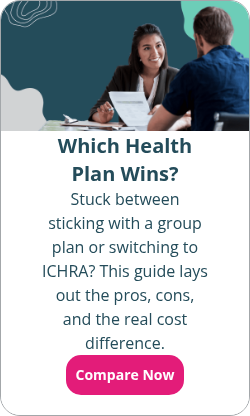How the Affordable Care Act (ACA) varies by state
By Elizabeth Walker on July 21, 2025 at 1:45 PM
The federal government created the Affordable Care Act (ACA) in 2010 to extend health insurance coverage and reduce financial risk for unexpected medical expenses for millions of uninsured adults.
The ACA health reform offered change in several ways, including expanding Medicaid services, creating the federal and state Marketplaces, preventing insurance companies from denying medical coverage due to pre-existing conditions, and requiring plans to cover 10 essential health benefits.
But, some aspects of the ACA may look different to those who reside in certain states. Your state can affect your medical care, health insurance options, and plan availability. Below, we’ll provide an overview of which parts of the ACA affect everyone and which depend on your state.
Is the ACA available in all states?
All states are subject to certain aspects of the ACA. Before the ACA, the CDC estimated1 that there were 48 million uninsured adults in the U.S. But now, the ACA guarantees basic health coverage, making medical care available to all Americans—from healthy individuals to those with chronic conditions—no matter where they reside.
The ACA had three primary goals:
- Make affordable medical coverage more accessible on the individual market.
- Expand Medicaid services to cover more adults.
- Reduce healthcare-related costs that affect both consumers and the federal government.
To meet these goals, the ACA mandated that all states set up a health insurance exchange or allow residents to purchase a plan on the federal Health Insurance Marketplace. The Marketplace lets individuals and families choose ACA-compliant coverage from various insurers.
Additionally, all 50 states must participate in the federal Medicaid program—whether they decide to implement Medicaid expansion coverage or not.
How the ACA is the same in every state
First, let’s review how the ACA is the same in every state.
1. Health insurance exchanges
Health insurance exchanges are the primary way uninsured adults shop for insurance in all states. Federal and state-based exchanges, or public health exchanges, allow individuals to browse various qualified health plans from different insurance companies. All standardized plans on public exchanges must be ACA-compliant.
There are also private health exchanges. Insurance companies and brokers can sell individual health plans to consumers and group health plans to employers on private exchanges. While public exchanges only offer ACA-compliant plans, private exchanges provide ACA-compliant and other health insurance plans, like supplemental policies such as dental coverage. While the federal government allows private exchanges, each state regulates the plans available for purchase.
Through these exchanges, individuals, families, and small businesses can register and enroll in healthcare plans to reduce the financial risk of unexpected illnesses.
2. Premium tax credits
In every state, the health insurance exchanges must offer financial assistance through premium tax credits and other cost-sharing reductions to those who meet specific income requirements.
People with incomes between 100% and 400% of the federal poverty level can get these subsidies on their federal income tax return or advance payment to help pay for their monthly insurance premiums upfront. The eligibility requirements for the subsidies are the same from state to state. However, some states have their own subsidies available.
The American Rescue Plan Act (ARP) expanded premium tax credits and cost-sharing reduction eligibility. Initially, these expanded subsidies would expire at the end of 2022. However, the Inflation Reduction Act in August 2022 extended the enhanced premium tax credits through 2025.
3. Metallic tiers of coverage
Regardless of state, all plans fall into one of four categories: bronze, silver, gold, or platinum. These four metal tiers adhere to a price structure that matches their medical coverage rates—not the quality of care you’ll receive.
Various health plan types, such as health maintenance organization (HMO) or preferred provider organization (PPO) plans, exist within each metal tier. Your plan type will determine your health outcomes, provider network, plan limitations, and what you'll pay to receive eligible medical services and items.
Generally, bronze and silver plans are best for young, relatively healthy individuals who don’t make frequent doctor visits. These plans typically have lower average premiums and larger deductibles. In contrast, gold and platinum plans are the best option for individuals with more medical needs. However, they tend to have higher premiums and lower annual deductibles.
4. Essential benefits
Insurance plans offered through the health insurance exchanges must cover 10 essential health benefits and provide minimum essential coverage (MEC). Essential health benefits include healthcare items and services that all qualified plans on the individual market must cover, like emergency services, hospitalization, prescription drugs, and mental health services.
Under the ACA, insurance companies can no longer lower their risk and expenses by only providing medical coverage to healthy individuals. They can also only vary premium rates based on age, region, and tobacco use.
Lastly, your insurance company can’t refuse to cover you or charge you more money if you have a pre-existing condition. Therefore, your financial risk for managing a chronic illness is lower with insurance than not having coverage.
5. Open enrollment
The annual open enrollment period to enroll or change health insurance plans is the same for all states using the federal Marketplace on HealthCare.gov2. This set time period ensures consumers don’t wait until they get sick to get a health insurance policy or switch to a health plan with greater coverage if they have a medical emergency.
Currently, state health insurance marketplaces can differ for enrollment periods. For most states, the open enrollment period generally starts on November 1 and ends on January 15. However, due to a new final rule, the annual Open Enrollment Period will begin on November 1 and end on December 15 for all states with public exchanges operating on the federal Health Insurance Marketplace3. This new timeline will become effective for the 2026 Open Enrollment Period.
You can only shop for health insurance outside of open enrollment if you trigger a special enrollment period during the year by experiencing a qualifying life event. If you open a special enrollment period, you have 60 days from your qualifying event to enroll in or change your health insurance plan.
How the ACA varies by state
The ACA mandated the creation of a formal health exchange in each state, but each person's health insurance experience will differ depending on their state. Here are three critical differences of the ACA from state to state.
1. How a state runs its health insurance exchange
Each state can design its own exchange, partner with the federal government, or default to the federally-run exchange to offer its residents quality health coverage.
For the 2024 plan year:
- 18 states and D.C. have entirely state-run Marketplaces
- 29 states use the federal Marketplace
- Of these states, six have state-federal partnership Marketplaces. States with these types of Marketplaces are similar to states that fully use the federal Marketplace but include more state participation in management and enrollment.
- Three states have state-based Marketplaces but use the federal Marketplace for plan enrollment.
As mentioned above, the Federal Marketplace's open enrollment period generally runs from November 1 to January 15. State-run exchanges can set their own deadline as long as their period doesn’t end before December 15.
When your policy starts will depend on when you enroll in coverage. For example, if an individual enrolls by December 15 and pays their first month’s premium, their coverage will become active starting January 1 of the following year. If they enroll in coverage by January 15, their policy will be active starting February 1.
If your state uses the federal government exchange, then the Marketplace website for employees, employers, and brokers is HealthCare.gov. If your state is running its own enrollment platform, it will have its own website where you can purchase Marketplace coverage.
Each state operating its own exchange regulates the plans available. Some states also provide their own premium tax credits for those ineligible for the federal subsidies. For example, Washington allows undocumented immigrants to enroll in a policy and claim new state subsidies known as Cascade Care Savings Plans4.
2. Individual mandate
Before 2017, the ACA required most people to obtain health insurance or pay a tax penalty. This was known as the individual mandate. The government repealed the individual mandate on the federal level in 2019.
However, some states chose to keep the individual mandate. New Jersey, Vermont, California, Rhode Island, Massachusetts, and the District of Columbia still require their residents to have health insurance. All individuals in these states, except Vermont, are subject to a tax penalty if they can afford health insurance but don’t enroll in coverage.
3. ACA Medicaid coverage expansion
Medicaid is an assistance program that provides health insurance coverage to roughly 72.5 million Americans5. Intended for low-income adults, uninsured individuals in all states can qualify for Medicaid services based on income, household size, disability, family status, and other factors. However, specific eligibility rules can vary between states.
To qualify for ACA Medicaid services, your annual income limit must be no more than 138% of the federal poverty level. Additionally, Medicaid eligibility rules have changed due to the One Big Beautiful Bill Act, which was passed by Congress on July 3, 20256. This includes individuals needing to meet work requirements, limitations on retroactive coverage, and restrictions on eligibility and Medicaid payments based on legal status.
Under the initial health reform laws, the ACA required all states to expand their Medicaid program. But in 2012, the Supreme Court left the decision to provide Medicaid expansion coverage up to individual states.
Currently, 41 states (including D.C.) have adopted the Medicaid expansion7. In states that have expanded Medicaid services, low-income people with household incomes under 133% of the federal poverty level will qualify. Under the OBBA, states that expanded Medicaid under the ACA will see significant reductions in federal funding.
If your state doesn’t have expansion coverage, your household income is less than the federal poverty level, and you don't qualify for Medicaid services under your state's rules, you can’t qualify for Medicaid or savings on a Marketplace health plan.
In this case, low-income adults should visit their community health center for medical care or see if they meet the conditions to qualify for a catastrophic health plan.
4. Health plan availability and cost
The availability and cost of a qualified health plan on the individual insurance market also varies by state. This is because each state has different regional populations and demographics, affecting healthcare providers and coverage options.
The prices of ACA-compliant coverage and other out-of-pocket costs will differ depending on which state you live in and even which region of your state you live in. Factors will include your age, ZIP code, and health plan selection.
For example, per federal guidelines, insurance companies can’t increase an individual’s overall premium above three times the base rate for the oldest individuals in their state. But, states can choose to lessen the gap even more between the premiums paid by their state's youngest and oldest people.
Many states have sample medical coverage exchange rates available, and all states will have final qualified health plan rates available for comparison during enrollment.
Conclusion
The ACA set out to provide affordable health coverage to more uninsured adults nationwide, regardless of their income, state, or health status. However, premium costs, expanded Medicaid services, and plan availability may differ from state to state.
When considering health insurance, it’s important to know how your state ranks against the rest of the country regarding premium rates, out-of-pocket costs, and access to coverage. Through careful research, you’ll have a greater understanding of where each state stands and how your state's regulations impact its residents' health outcomes.
This article was originally published on September 23, 2013. It was last updated on July 21, 2025.
Check out more resources
See these related articles

What is the Affordable Care Act (ACA)?
The Affordable Care Act (ACA) expanded access to health insurance. Learn what the ACA is, what it requires, and how it impacts individuals and employers.

What happens if you miss Open Enrollment for individual health insurance?
Missed Open Enrollment for health insurance? Find out what options you have, including qualifying life events and special enrollment periods (SEPs).

A state-by-state guide to extended open enrollment periods
Did your state extend the annual open enrollment period? Find out in this comprehensive guide detailing the extended open enrollment periods across all states.



